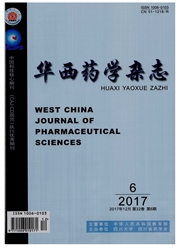

 中文摘要:
中文摘要:
目的研究川木通对大鼠肾脏的慢性毒性作用。方法用《中国药典》品种小木通Clematis armandiiFranch.、绣球藤C.montanaBuch.-Ham.和市场混乱品种粗齿铁线莲C.argentilucidaW.T.Wang、钝萼铁线莲C.peteraeHand.-Mazz的水煎液(10 g·kg^-1·d^-1)与关木通Aristolochia manshuriensisKom水煎液(2 g·kg^-1·d^-1)每天给大鼠灌胃1次,连续给药4周,观察大鼠的活动情况及体重,分析尿、血浆的生化指标,做肾脏组织的病理学检查。结果给药期间各组大鼠行为活动未见明显异常,与对照组和关木通组比较体重无显著差异。对大鼠尿量、尿糖、尿蛋白及BUN、SCr等指标和肾脏组织形态学进行分析,川木通各品种均未见明显肾毒性。结论连续给药4周,药典品种川木通各品种未见明显肾毒性。
 英文摘要:
英文摘要:
OBJECTIVE To investigate the renal toxicity of Caulis clematidis armandii in rats. The safety of four herbal drugs ( Clematis armandii Franch. , C. montana Buch. - Ham. , C. argentilucida W. T. Wang, and C. peterae Hand. - Mazz. ) was evaluated. METHODS Rats were randomly dividead into six groups and administrated with the former four herbal drugs( 10 g·kg^-1 · d^- 1 ) and Caulis clematidis armandii(2g·kg^-1 · d^- 1) by oral administration. During the experiment, the activites of rats were observed and the weight of rats were also measured. Then, the urine sample analysis, blood biochemical analysis and histopathological analysis were carfled out. RESULTS GuaM Mutong shows obvious renal toxicity. Compared to the resuhs of control group and GuaM Mutong group, the activities and weight of rats in other four groups were normal. CONCLUSION The results indicate that the four herbal drugs may be safe in clinical study.
 同期刊论文项目
同期刊论文项目
 同项目期刊论文
同项目期刊论文
 期刊信息
期刊信息
